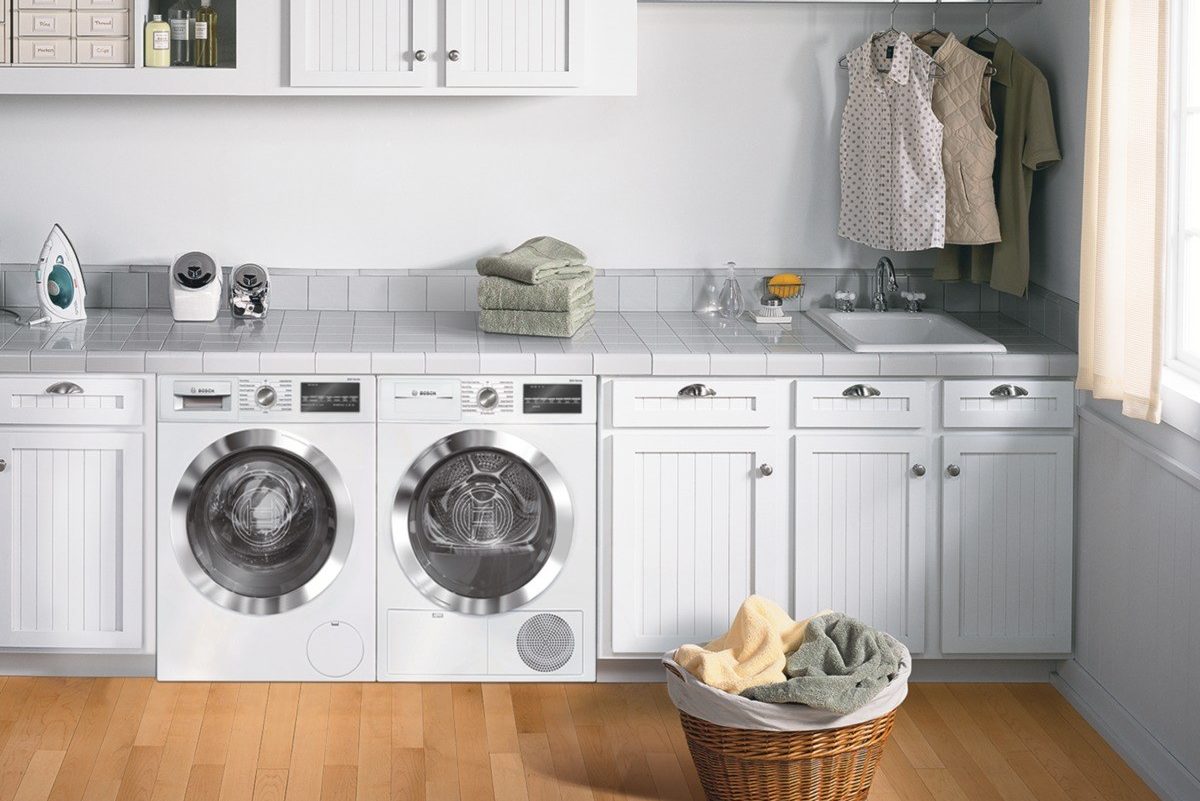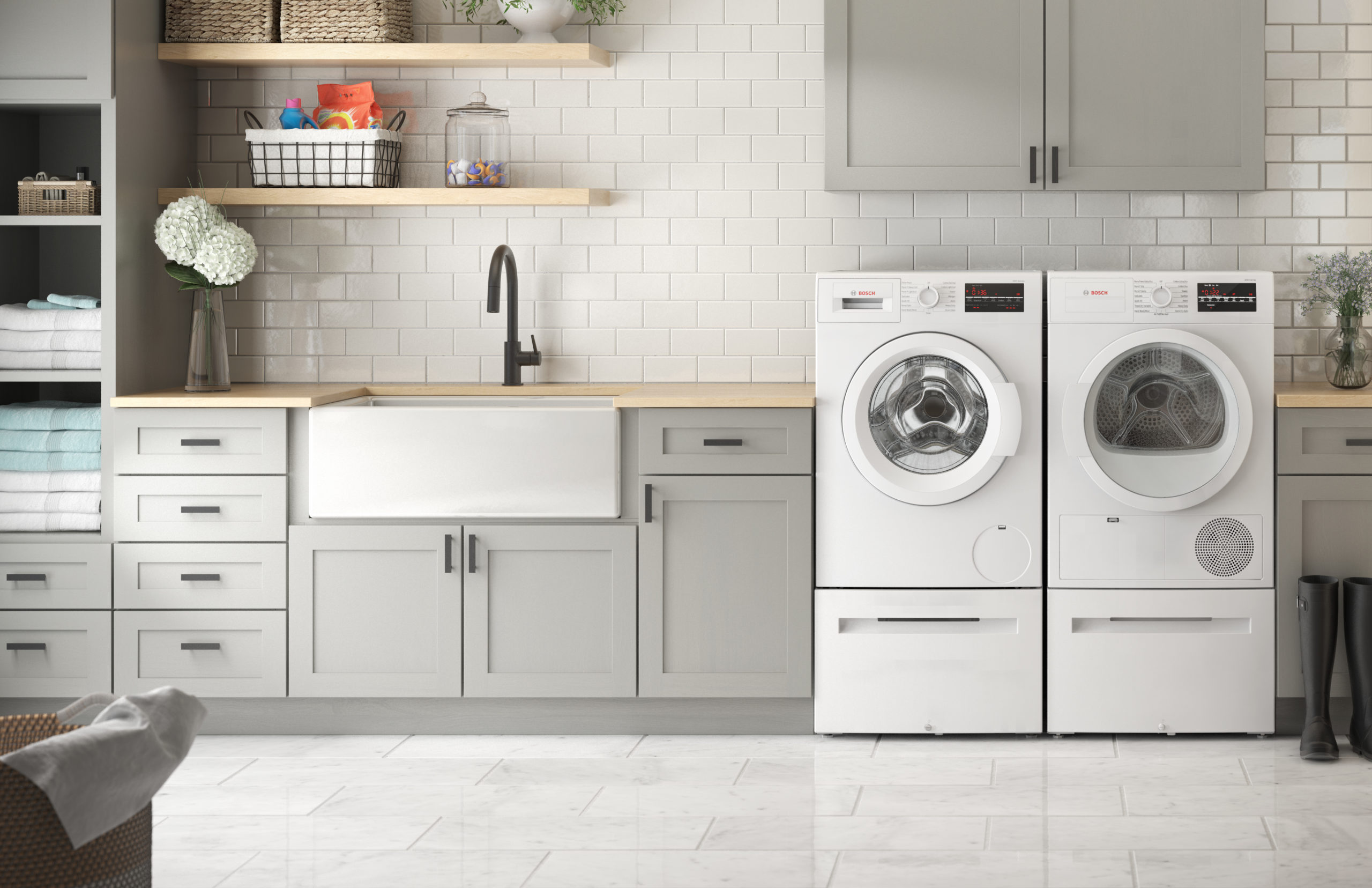

Laundry is an endless chore, and the more people you have in your family, the more you’re rinsing and repeating. The right washer and dryer can save you time and energy. But walking through an aisle of these sleek machines can be like stepping into the future, full of touch screens, flashing lights, and high-tech features. If trying to choose is making your head spin, we’re here to help with a guide to finding the best machines for large families.
There are three main washer types to consider.
Top-Load Agitator
These machines are the least expensive. They have shorter cycles, easy-to-use control panels, and don’t require bending down to load your laundry.
Cons: They use more water and energy, have smaller drums (so smaller loads), and can’t be stacked. Plus, the agitator is rougher on clothing.
High-Efficiency Top-Loading Washers
HE machines are more expensive than top-load agitators but are usually more affordable than front-loaders, especially if you purchase models with fewer fancy features. They can handle large loads, use less water, are gentle on clothes, and rarely cause musty odors.
Cons: They have lengthy wash cycles, can be noisy, and can’t be stacked.
Front-Loading Washer
These HE machines are the best at cleaning, have larger drums for larger loads of laundry, can be stacked, are gentle on clothes, and are typically the quietest.
Cons: They are also the most expensive, have long wash cycles, and can cause musty odors because of the front-load design.
Best Features to Look for in a Washing Machine
Now that you’ve got the basic idea of types of washing machines, let’s get into the laundry list of features and capabilities to figure out which ones will make your life easier.
Capacity
So, what size washing machine do you need for a large family? Darren Cleveland, Contractor of Sales at The Jarrell Company in Dallas, says he recommends a washer with a capacity of 4.2 cubic feet or more. If you’re of the Texas philosophy that bigger is better, you’ll be pleased to discover along with energy efficiency, HE washers also have bigger-than-ever drums. (For reference, while compact washers offer a capacity of around 2.3 cubic feet, most HE models range from 4.5 to 6.2 cubic feet.) Samsung’s Total Capacity Smart Dial Washer with FlexWash and Super Speed Wash, for example, has a massive 6 cubic feet capacity, which means you can wash 17 large bath towels at one time. Though bigger drum size means more laundry done at once, you don’t necessarily need a washer with maximum capacity for big jobs. Even machines with 4.5 cubic foot capacity can handle a king-sized comforter.
Cleaning Ability
If you have kids, you likely have hampers brimming with a rainbow of stains. For best cleaning power, Cleveland recommends front-loaders. “Front loads are going to clean better because your clothes are taken through water over and over again as the tub agitates,” he says. The downside is front-loaders can create musty smells caused by water puddling inside the door. To combat this, GE Appliance made the UltraFresh Front Load Washer with OdorBlock, which uses a venting system to dry moisture after washes.
If it’s the top-loader life for you, Cleveland recommends LG or Maytag brands for maximum cleaning efficiency and gentleness on clothing, like the LG Smart Wi-Fi Enabled Top Load Washer with TurboWash3D Technology.
For a no-frills option with some of the best cleaning performance, Cleveland says consider a Speed Queen. The TC5 Top Load Washer has a traditional agitator, and even though it has a smaller capacity than other brands, it’s still capable of handling heavy loads. “It’s the same machine you’d find in a laundromat, without the coin machine,” Cleveland says. The standout feature is that the machine is built to last. “Regular top-loaders or front-loaders are lasting for about eight years,” he says. “The Speed Queens, those are going closer to 20.” If you want a washing machine to be with your family longer than a decade, this is the best washer for you.
Speed
Top-loading washers with agitators hold the speed record. “Most of the energy-saving machines are going to take longer to do a wash,” Cleveland says. “They use less water, but in order to do so, they need more time to get everything as clean.” But if HE washers are your preference, look for models with quick-wash options, light-soil cycles, and faster spin speeds, which wring out more water and cut down on dry time.
Noise
If your washer and dryer will neighbor a sleeping baby, Cleveland suggests Miele washers as the quietest machines. But they’re compact at only 2.2 cubic feet, so what you’ll gain in silence, you’ll lose in space.
Energy Efficiency
High-efficiency (or HE) machines are the best washers for saving money and the earth. They use less water, energy, and detergent than traditional washers. They cost more money up front, but save more in the long run. “Everyone is pushing toward the high-efficiency products because they’re using far less water,” says Cleveland. “For reference, most of the HE products you’ll find are using 14 to 18 gallons of water, where the non-HE products are pushing closer to 36 gallons of water.”
Cycles
Whether you’re washing (and rewashing) kids bedding, play clothes, delicate tutus, pricey yoga pants, massive bundles of towels, and more, there’s a cycle for it. Many machines come with a variety of built-in options, including hand wash, bedding, sanitization and quick wash.
Special Features
There are a handful of fancy features that make laundry life breezier: deep fill, delayed start, steam cycle, self-clean cycle, smart dispensing trays, detergent packet dispensers, and Wi-Fi capability, so you can start your machine via app, Alexa, or Google Assistant and get an alert when loads are finished.
Availability
The pandemic has shaken up the appliance market. Asking about availability is as critical as asking about capacity or features right now. If you know purchasing a new washer or dryer is in your not-too-distant future, now may be a good time to shop so you have them ordered in advance.
Features to Look for in a Dryer
Picking the washer’s matching dryer is the easiest way to go and the most common, Cleveland says. It makes for an aesthetically clean laundry room and provides the proper capacity. (The dryer capacity needs to be bigger than that of the washer so that wet laundry is able to expand and tumble around.)
Electric or Gas
Electric dryers come in a wide variety and cost less upfront. Many homes already have the wiring in place, and installation is as easy as plugging it in.
Gas dryers are a little pricier up front, but can save you money in the long run. Gas is cheaper and provides heat faster, which reduces dry time by up to half.
Other Features to Consider
Stainless Steel Drum
Dryers with stainless steel drums resist damage, fight odors, and are gentler on clothes.
Moisture Sensor
A humidity sensor detects dampness and ends the cycle when laundry is dry, which saves energy and protects clothing from over-drying.
Auto-Dry Cycles
Some dryers will determine the length of dry time necessary for you and let you select the level of dryness.
Extended Tumble
If you can’t get the laundry out of the dryer immediately, some dryers will intermittently tumble the clothes to keep things from getting wrinkly.
End-of-Cycle Signal
When you’re busy multitasking, your dryer can beep a little tune at you to let you know it’s done.
Steam Cycle
Some dryers, like the LG Ultra Large SteamDryer with EasyLoad Door, have a steam cycle, which helps release wrinkles, cuts down on ironing time, and fights allergens.
Find Your New Washer and Dryer at The Jarrell Company
Need more help? We’d love to lighten your load and guide you toward the best washing machine and dryer for your family. We’ll also deliver and install your new machines for you. Give The Jarrell Company a call today, or come explore our brands in person at one of our two locations.

